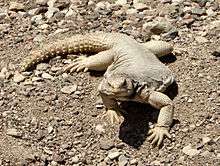Uromastyx aegyptia
Uromastyx aegyptia is a species of lizard in the family Agamidae. The species is endemic to North Africa and the Middle East.[1]
| Uromastyx aegyptia | |
|---|---|
 | |
| Scientific classification | |
| Kingdom: | Animalia |
| Phylum: | Chordata |
| Class: | Reptilia |
| Order: | Squamata |
| Suborder: | Iguania |
| Family: | Agamidae |
| Genus: | Uromastyx |
| Species: | U. aegyptia |
| Binomial name | |
| Uromastyx aegyptia (Forskål, 1775) | |
| Synonyms | |
| |
Common names
Common names for U. aegyptia include Egyptian mastigure,[3] Egyptian spiny-tailed lizard, Leptien's mastigure,[4] Egyptian Uromastyx and Egyptian dabb lizard.
Description
U. aegyptia is one of the largest members of the genus, with average lengths of 76 cm (30 in) for males.
Geographic range and conservation status
U. aegyptia can be found in Egypt,[5] Libya, Palestine, Israel and throughout the Middle East but is rarely found today due to reduction of habitat. The remainder of the population mostly inhabits the gravel plains of northern Oman and some parts of the eastern UAE and Saudi Arabia where it is listed as endangered and slowly vanishing due to the impact brought on by development.
Subspecies
Three subspecies are recognized as being valid, including the nominotypical subspecies.[2]
- Uromastyx aegyptia aegyptia (Forskål, 1775)
- Uromastyx aegyptia leptieni Wilms & Böhme, 2000
- Uromastyx microlepis Blanford, 1874
Etymology
The subspecific name, leptieni, is in honor of German herpetologist Rolf Leptien.[6]
Economic use
U. aegyptia is locally known as dhab or ḍabb (Arabic: ضب). Its strong skin made good leather for the bedouins, while its meat was often considered as an alternative source of protein.[7]
Habitat
U. aegyptia lives in dry, rocky areas.[2]
References
- Wilms T, Eid EKA, Al Johany AMH, Amr ZSS, Els J, Baha El Din S, Disi AM, Sharifi M, Papenfuss T, Shafiei Bafti S, Werner YL (2012). "Uromastyx aegyptia ". IUCN Red List of Threatened Species. 2012. Retrieved 4 September 2014.CS1 maint: uses authors parameter (link) CS1 maint: ref=harv (link)
- "Uromastyx aegyptia (FORSKAL, 1775)". The Reptile Database. Retrieved 2009-01-25.
- http://jcvi.org/reptiles/species.php?genus=Uromastyx&species=aegyptia
- http://animaldiversity.ummz.umich.edu/site/accounts/classification/Uromastyx_leptieni.html
- Baha el Din, Sherif (2006). A Guide to Reptiles & Amphibians of Egypt. Cairo: The American University in Cairo Press. ISBN 978-9774249792.
- Beolens, Bo; Watkins, Michael; Grayson, Michael (2011). The Eponym Dictionary of Reptiles. Baltimore: Johns Hopkins University Press. xiii + 296 pp. ISBN 978-1-4214-0135-5. (Uromastyx leptieni, p. 155).
- Ghose, Tia (2014-03-05). "Leapin' Lizards! Medieval Arabs Ate the Scaly Creatures". LiveScience.com. Retrieved 2015-04-20.
Further reading
- Forskål P (1775). Descriptiones Animalium, Avium, Amphibiorum, Piscium, Insectorum, Vermium; quæ in Itinere Orientali Observit. Copenhagen: Möller. 164 pp. (Lacerta ægyptia, new species, p. 13). (in Latin).
External links
- Egyptian Spiny-Tail Agama, Sea Dwellers & Friends.
